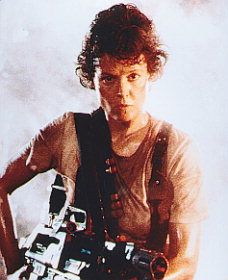Republic of two
Why watch so many films? (I sometimes ask myself.) Our collective dreams interest me more than my own do.
There is some part of the Landmark Forum (a self-development course), taken, I think, from Gestalt Therapy, that invites participants to imagine which fictional character would make their ideal partner. There is almost always a man who nominates Sigourney Weaver’s Ellen Ripley from Alien
This, and the proliferation of action heroines – think Angelina Jolie’s Lara Croft and Milla Jovovic & Michelle Rodriguez’s characters from Resident Evil – marks a sea-change in how relations between the sexes are imagined.
First to note is that not only are these women no longer prizes to be shielded and rescued, they have virtue in the classical sense: they are brave, steadfast, smart. It is they who see and shoot straight, confound the enemy, save the world. The best of their men are only their sidekicks.
Even the profoundly misogynistic and phallocentric James Bond franchise is changed. Tomorrow Never Dies saw Michelle Yeoh join him in action; last year’s Quantum of Solace had him collaborating with Olga Kurylenko’s Camille, who was seeking a vengeance of her own.
Jolie’s Lara Croft is not only a female virtuous man, she has also assumed James Bond’s former ease, dispatching villains with a grim twinkle and a quip. Daniel Craig’s Bond has not inherited this confidence from his predecessors; he is, as one reviewer put it, ‘an anxious gym bunny’.
This reflects the decline in men’s confidence reported in a recent survey, attributed to an increasingly feminised world in which the ‘soft skills’ of communication and collaboration outgun male traditions of command and control.
All men may be brothers, but we are paying attention to our sisters in new ways. The idealised brides on our screens are sisters-in-arms. “What happens,” asks Richard Gere’s character in Pretty Woman, “after the prince rescues the princess from the tower?” “Why,” replies Julia Roberts’s character, “she rescues him right back.”
Nothing new under the sun? There is a precedent for this, described in Alan Bray’s history, The Friend. Bray describes his puzzlement at finding the tomb of two crusading knights with their arms displayed as if they were married. Research uncovered a mediaeval tradition of wedded brothers. This was not a homosexual marriage, but a mutual swearing of fidelity, an oath to supersede all others. Wedded brothers could count on each other to death. (Compare the US Army’s ‘buddy’ system.)
Such oaths were deeply subversive, slicing across loyalties to parents and lords. The mediaeval tradition was ripe with tales of these conflicts. One, cited by Bray, tells of two wedded brothers whose fathers went to war against each other. Unable to renounce the duty each owed his father, the two took their own lives rather than bear arms against each other. These tragedies may well have been largely fanciful, but they caught the mediaeval imagination.
We can see in them the seeds of modernity. Oaths of allegiance to parents and lieges affirmed a relationship into which one was born. The wedding of brothers was chosen, a movement of the heart, and crucially given priority over all social bonds; a focus for both joy and terror. It was an oath taken and given, freely, between equals.
Nicholas Battye used to argue that romantic love was possible only between people with comparable power, which is why its paradigm in classical Greece was homosexual: think of Achilles and Patroclus, Plato’s Symposium or the surviving fragments of Sappho’s love poetry. He also argued that the mediaeval Grail romances, such as Tristran & Yseult, depended upon the high status given to ‘the lady’ by the originally Arabic poetic cult brought up from Sicily by the Provencal troubadours. Without this, women could be imagined only as prizes to be taken and enjoyed: think Helen of Troy, and just about every woman in Thomas Malory’s Le Morte D’Arthur or any Ian Fleming novel.
From our modern perspective we see the tale of Tristran and Yseult as an early, albeit tragic, celebration of passion. Nicholas claimed we misconstrue it; that it was to be read as a warning against the subversive and disruptive dangers of romantic passion. But, considering Bray’s account of the tradition of wedded brotherhood, I’m inclined to think Nicholas overstated his case. The long popularity of both tragedies indicates, I think, a centuries-long yearning for the life chosen over the life given. To be loved romantically is to be chosen above all bonds of family and society, over all claims of usefulness, to be recognised – in Kant’s formulation – as an ends rather than a means.
The folie à deux of romance is the seed crystal of the democratic republic.


